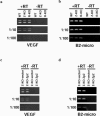Epstein-Barr virus lytic infection is required for efficient production of the angiogenesis factor vascular endothelial growth factor in lymphoblastoid cell lines
- PMID: 16254334
- PMCID: PMC1280197
- DOI: 10.1128/JVI.79.22.13984-13992.2005
Epstein-Barr virus lytic infection is required for efficient production of the angiogenesis factor vascular endothelial growth factor in lymphoblastoid cell lines
Abstract
Although Epstein-Barr virus (EBV)-associated malignancies are primarily composed of cells with one of the latent forms of EBV infection, a small subset of tumor cells containing the lytic form of infection is often observed. Whether the rare lytically infected tumor cells contribute to the growth of the latently infected tumor cells is unclear. Here we have investigated whether the lytically infected subset of early-passage lymphoblastoid cell lines (LCLs) could potentially contribute to tumor growth through the production of angiogenesis factors. We demonstrate that supernatants from early-passage LCLs infected with BZLF1-deleted virus (Z-KO LCLs) are highly impaired in promoting endothelial cell tube formation in vitro compared to wild-type (WT) LCL supernatants. Furthermore, expression of the BZLF1 gene product in trans in Z-KO LCLs restored angiogenic capacity. The supernatants of Z-KO LCLs, as well as supernatants from LCLs derived with a BRLF1-deleted virus (R-KO LCLs), contained much less vascular endothelial growth factor (VEGF) in comparison to WT LCLs. BZLF1 gene expression in Z-KO LCLs restored the VEGF level in the supernatant. However, the cellular level of VEGF mRNA was similar in Z-KO, R-KO, and WT LCLs, suggesting that lytic infection may enhance VEGF translation or secretion. Interestingly, a portion of the vasculature in LCL tumors in SCID mice was derived from the human LCLs. These results suggest that lytically infected cells may contribute to the growth of EBV-associated malignancies by enhancing angiogenesis. In addition, as VEGF is a pleiotropic factor with effects other than angiogenesis, lytically induced VEGF secretion may potentially contribute to viral pathogenesis.
Figures






References
-
- Adamson, A. L., D. Darr, E. Holley-Guthrie, R. A. Johnson, A. Mauser, J. Swenson, and S. Kenney. 2000. Epstein-Barr virus immediate-early proteins BZLF1 and BRLF1 activate the ATF2 transcription factor by increasing the levels of phosphorylated p38 and c-Jun N-terminal kinases. J. Virol. 74: 1224-1233. - PMC - PubMed
-
- Akiri, G., D. Nahari, Y. Finkelstein, S. Y. Le, O. Elroy-Stein, and B. Z. Levi. 1998. Regulation of vascular endothelial growth factor (VEGF) expression is mediated by internal initiation of translation and alternative initiation of transcription. Oncogene 17:227-236. - PubMed
-
- Aoki, Y., E. S. Jaffe, Y. Chang, K. Jones, J. Teruya-Feldstein, P. S. Moore, and G. Tosato. 1999. Angiogenesis and hematopoiesis induced by Kaposi's sarcoma-associated herpesvirus-encoded interleukin-6. Blood 93:4034-4043. - PubMed
-
- Aoki, Y., and G. Tosato. 1999. Role of vascular endothelial growth factor/vascular permeability factor in the pathogenesis of Kaposi's sarcoma- associated herpesvirus-infected primary effusion lymphomas. Blood 94: 4247-4254. - PubMed
-
- Aoki, Y., and G. Tosato. 2001. Vascular endothelial growth factor/vascular permeability factor in the pathogenesis of primary effusion lymphomas. Leuk. Lymphoma 41:229-237. - PubMed
Publication types
MeSH terms
Substances
Grants and funding
LinkOut - more resources
Full Text Sources
Research Materials

